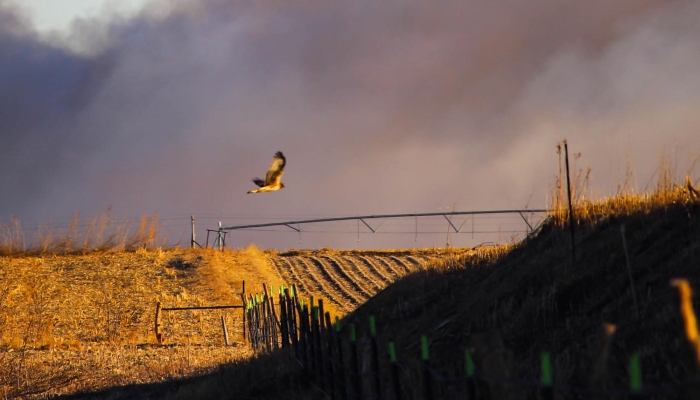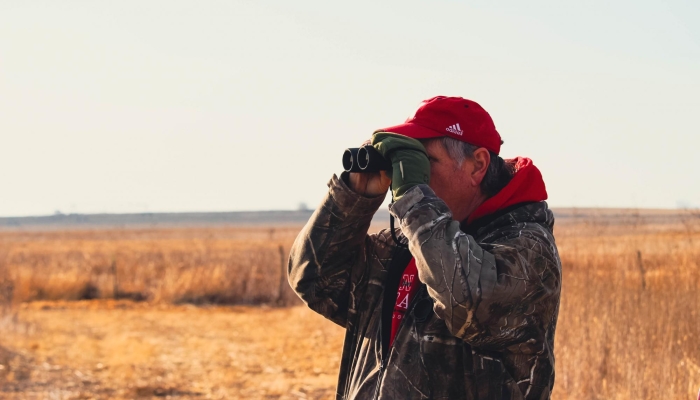Birds Abound at Teal View
NRD Hosts Event at Wetland Education Area Near Hampton
If the early bird gets the worm, it’s the early rising bird watcher that gets the photo.
The chooks and squawks of pheasants and turkeys, as well as the high-pitched cries of a killdeer and the vibrant song of red-winged blackbirds filled the air as a small group of nature lovers explored Teal View Wetland Education Area in the early morning hours on Saturday, March 19. The birding event hosted by the Upper Big Blue Natural Resources District drew a small crowd, but was a wonderful experience for those who attended.
Participants spread out across the 39-acre public wetland, some walking along the perimeter and others settling down among the dried stalks of vegetation to observe. The Nebraska Game and Parks Commission provided binoculars and birding guides for the event. Participants spotted a barn owl, a red-tailed hawk, geese, meadowlarks, and several other species.
Due to the low level of precipitation through the winter months, Teal View Wetland Education Area was quite dry. While it hasn’t attracted the variety of ducks and other waterfowl this year as it did last year due to the dry conditions, the wetland was still filled with avian activity.
According to the Nebraska Game and Parks website, Nebraska contains more acres of wetlands than any surrounding state. These wetlands are very diverse and dynamic and include marshes, lakes, river and stream backwaters, oxbows, wet meadows, fens, forested swamps, and seeps. Wetlands are a vital piece of Nebraska’s landscape as they provide water filtration, aquifer recharge, and wildlife habitat.
Teal View Wetland Education Area was restored in the last few years in partnership with Ducks Unlimited, Natural Resources Conservation Service, Nebraska Environmental Trust, and Rainwater Basin Joint Venture. Ducks Unlimited deeded the property to the Upper Big Blue Natural Resources District in 2021 as part of their Revolving Lands Program, which restores wildlife areas and then passes them on to other entities to hold in conservation easement while providing public access.
A red-winged blackbird is silhouetted by the sunrise at Teal View Wetland Education Area.

Most of Nebraska’s network of wetlands has been destroyed or degraded in the last hundred years, as the land has been drained and converted to some of the most productive agricultural real estate in the world. What has been lost is harder to quantify than the number of acres. Wetlands improve water quality by filtering agrichemicals before they enter the groundwater supply. They provide habitat for thousands of species of plants, animals, and insects. They reduce the impacts of flooding and prevent soil erosion. A functioning system of wetlands is an essential part of the landscape for a healthy and productive place to call home, for humans and animals alike.
Many of Nebraska’s wetlands have been drained and filled to make way for row crops. Today the benefits of wetlands are being recognized more often as the intensity of rain events increase. As a result, there is a greater need for the flood control and water filtration wetlands provide.
The Upper Big Blue NRD is partnering with other agencies to protect this spot and use it to educate the public on the importance of wetlands in Nebraska. More birding events are planned for the property in the future, but it is open to the public for wildlife viewing at any time. For more information about Teal View and other NRD recreation areas, visit www.upperbigblue.org/recreation.
Young writer Lily Houston made use of the visit to Teal View Wetland Education Area to craft some poetry inspired by the Nebraska landscape.

If the early bird gets the worm, it’s the early rising bird watcher that gets the photo.
The chooks and squawks of pheasants and turkeys, as well as the high-pitched cries of a killdeer and the vibrant song of red-winged blackbirds filled the air as a small group of nature lovers explored Teal View Wetland Education Area in the early morning hours on Saturday, March 19. The birding event hosted by the Upper Big Blue Natural Resources District drew a small crowd, but was a wonderful experience for those who attended.
Participants spread out across the 39-acre public wetland, some walking along the perimeter and others settling down among the dried stalks of vegetation to observe. The Nebraska Game and Parks Commission provided binoculars and birding guides for the event. Participants spotted a barn owl, a red-tailed hawk, geese, meadowlarks, and several other species.
Due to the low level of precipitation through the winter months, Teal View Wetland Education Area was quite dry. While it hasn’t attracted the variety of ducks and other waterfowl this year as it did last year due to the dry conditions, the wetland was still filled with avian activity.
According to the Nebraska Game and Parks website, Nebraska contains more acres of wetlands than any surrounding state. These wetlands are very diverse and dynamic and include marshes, lakes, river and stream backwaters, oxbows, wet meadows, fens, forested swamps, and seeps. Wetlands are a vital piece of Nebraska’s landscape as they provide water filtration, aquifer recharge, and wildlife habitat.
Teal View Wetland Education Area was restored in the last few years in partnership with Ducks Unlimited, Natural Resources Conservation Service, Nebraska Environmental Trust, and Rainwater Basin Joint Venture. Ducks Unlimited deeded the property to the Upper Big Blue Natural Resources District in 2021 as part of their Revolving Lands Program, which restores wildlife areas and then passes them on to other entities to hold in conservation easement while providing public access.
A red-winged blackbird is silhouetted by the sunrise at Teal View Wetland Education Area.

Most of Nebraska’s network of wetlands has been destroyed or degraded in the last hundred years, as the land has been drained and converted to some of the most productive agricultural real estate in the world. What has been lost is harder to quantify than the number of acres. Wetlands improve water quality by filtering agrichemicals before they enter the groundwater supply. They provide habitat for thousands of species of plants, animals, and insects. They reduce the impacts of flooding and prevent soil erosion. A functioning system of wetlands is an essential part of the landscape for a healthy and productive place to call home, for humans and animals alike.
Many of Nebraska’s wetlands have been drained and filled to make way for row crops. Today the benefits of wetlands are being recognized more often as the intensity of rain events increase. As a result, there is a greater need for the flood control and water filtration wetlands provide.
The Upper Big Blue NRD is partnering with other agencies to protect this spot and use it to educate the public on the importance of wetlands in Nebraska. More birding events are planned for the property in the future, but it is open to the public for wildlife viewing at any time. For more information about Teal View and other NRD recreation areas, visit www.upperbigblue.org/recreation.
Young writer Lily Houston made use of the visit to Teal View Wetland Education Area to craft some poetry inspired by the Nebraska landscape.



